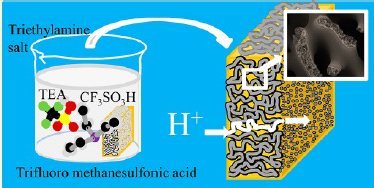Copyright 2012 neutronsources.org | All rights reserved. | Powered by FRM II | Imprint / Privacy Policy
High-temperature ionic-conducting material: advanced structure and improved performance
A. Menelle, 19/09/2013

A new composite proton-conducting material based on the association of an ionic liquid and a porous polymer support was prepared with the aim of applying it as an electrolyte in a proton exchange membrane fuel cell (PEMFC) at elevated temperature (130 °C). The porous support was made from a high glass-transition temperature polymer (Tg) by using the vapor-induced phase separation (VIPS) method in conditions leading to highly interconnected porous films. The ionic liquid tested was obtained by the reaction of a sulfonic acid with a tertiary amine and presents enough high-temperature stability to be used at elevated temperatures. Composite samples were prepared by immersing pieces of porous film in the ionic liquids under test. The porous support was characterized by scanning electron microscopy (SEM), gas permeation, and thermogravimetric analysis (TGA) tests, and the composite samples were characterized by mechanical and proton-conduction measurements. At 130 °C, this new material exhibits proton conductivity (20 mS cm−1) below, but very close to, that of the pure ionic liquid (31 mS cm−1) and presents, up to at least 150 °C, a storage modulus exceeding 200 MPa. This is very promising considering the PEMFC applications.
D. Langevin, Q. T. Nguyen, S. Marais, S. Karademir, J.-Y. Sanchez, C. Iojoiu, M. Martinez, R. Mercier, P. Judeinstein, C. Chappey
Original Publication
High-Temperature Ionic-Conducting Material: Advanced Structure and Improved Performance D. Langevin et al, J. Phys. Chem. C 117 (30) (2013) 15552